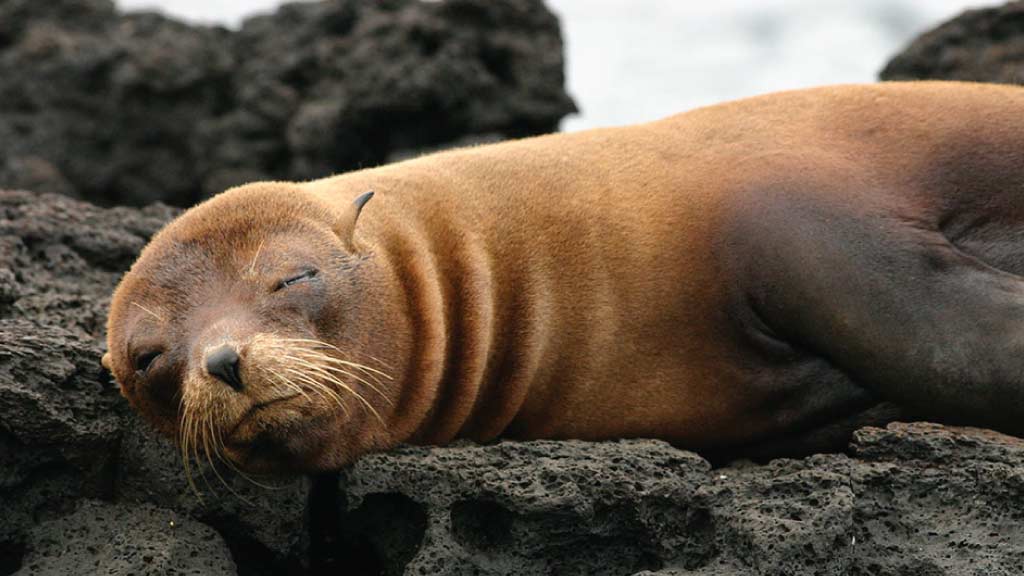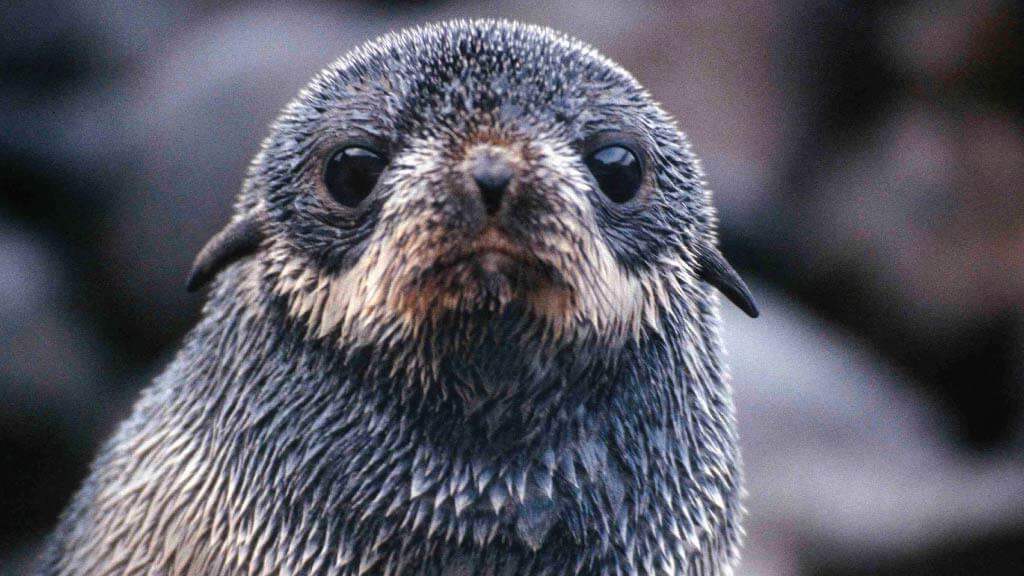GALAPAGOS FUR SEAL
The Galapagos Fur Seal is undeniably cute. Those big puppy-dog eyes looking up at you, and furry little bodies certainly make them popular with visitors. But, the Galapagos fur seal is a very shy and retiring creature. Although their population size is similar to that of the Galapagos Sea Lion, it is far more unusual to encounter them. Lucky tourists will most likely come across Galapagos fur seals huddled together in protected grottos or on rocky outcrops. But it's only possible to see them at certain visitor sites of the archipelago, so, you'll need to carefully plan your Galapagos itinerary in order to see one.
Read on to learn more about the endemic Galapagos Fur Seal. Where and When can you see them? Plus heaps of other fun Galapagos Fur Seal facts.
SECURE YOUR GALAPAGOS TRAVEL
Get a FREE personalised quote todayThe Galapagos Fur Seal is an: ENDEMIC SPECIES
Conservation Status: Endangered
Scientific Name: Arctocephalus Galapagoensis
How to See a Galapagos Fur Seal?
The Galapagos Fur Seal population is estimated at about 10,000-15,000 individuals. They live on almost all Galapagos islands but can be difficult to spot during the day. Galapagos fur seals typically hang out in shady caves or rocky grottos to escape the sun and are most active at night.
WHERE to spot a Galapagos Fur Seal?
Galapagos Sea Lions are literally everywhere, but it's much more of a challenge for visitors to find Galapagos Fur Seals. There are three Galapagos sites for the most reliable Galapagos Fur Seal sightings: James Bay (Santiago), Darwin Bay (Genovesa), and on the west coast of (Isabela island). These are all cold water zones of the Galapagos archipelago. The colder water temperature results in richer nutrients and marine life, making the perfect feeding grounds for the Galapagos fur seal.
WHEN to see fur seals at Galapagos?
Galagapos Fur Seals call the Galapagos Islands home all year round, so it's possible to spot them every month of the year. Their nesting season lasts from August to November when the ocean is at its coldest and food is abundant. If you want to see cute Galapagos fur seal pups, then October is usually the best month to visit.
Contact us for a FREE GALAPAGOS TOUR QUOTE with no obligations, or for more information about how to plan your vacation to the Galapagos Islands.
Everything You Need To Know About Galapagos Fur Seals
Galapagos Fur Seal vs Galapagos Sea Lion - How to tell the difference?
Tourists often confuse the Galapagos Fur Seal with Sea Lions. At first glance they do look rather similar, so it's an easy mistake to make. How to tell the difference? There are 3 tell-tale giveaways: firstly, Galapagos Fur Seals have thicker and furrier coats. Secondly, Fur Seals have bulgier eyes and more protruding ears than sea lions. Finally, the Galapagos Fur Seal tends to be smaller in size, with a broader and shorter head.
Another interesting distinction is that the Galapagos fur seal is much shyer than the sea lion. They tend to hang out together in hidden and shady rocky grottos. Sea lions, on the other hand, are very social creatures, commonly spotted lazing on sandy beaches where they'll often come right up to visiting tourists. Snorkeling with a Galapagos sea lion is often a big trip highlight, but you'll rarely share the same experience with a Galapagos fur seal.
The Galapagos Fur Seal is the smallest member of the eared-seal family (otariids). Adults have a thick grayish-brown fur coat, while newborns adorn a black coat that turns brown after molting.
Still confused? If all else fails your naturalist tour guide will be more than happy to help you make a correct identification.
GET FREE ADVICE
From a Galapagos destination expert todayGalapagos Fur Seal Behavior
Galapagos Fur Seals tend to live in large colonies. During the breeding season, territories are divided between dominant males. Each male will protect his breeding ground on land to prevent any rival from taking advantage. They need to be on attention nonstop, and will even forgo food for much of the day. This behavior eventually becomes counterproductive as the dominant fur seal male loses weight and strength. Another Galapagos fur seal male can then move into his territory and the process is repeated.
Pregnant reproductive females are also territorial and will claim a specific area of beach to raise their pup. Galapagos Fur seals have the lowest reproductive rate of all seal species, bearing just one pup at a time. The mother fur seal stays at the side of her newborn for a week, before leaving on hunting trips, returning to suckle the pup. When she returns from the sea, a mother can recognize her pup by smell and sound. This is important because female Galapagos fur seals exclusively nurse their own pups, and will often violently reject any other.
Galapagos Fur Seal Habitat
Galapagos fur seals prefer to live in rocky areas, close to large boulders or lava caves. Here they find protection from the strong daytime sun and keep themselves to themselves.
Galapagos Fur Seal Diet
What do Galapagos Fur Seals eat? Their diet consists mainly of fish, squid, and shellfish. Galapagos Fur Seals hunt at night, using their large eyes with night vision to locate their prey. Food is caught by diving to depths of between 10 & 50 meters close to shore. Night-hunting helps them to reduce the risk of predation by sharks.
Why are Galapagos Fur Seals endangered?
Galapagos fur seals are listed as endangered with a declining population trend on the IUCN Red List.
In truth, their population numbers have fluctuated greatly over the centuries. Their thick fur may keep them warm, but it also attracted fur hunters. The pelt of fur seal pups was particularly sought after for its silky smooth properties. Throughout the 1800s they were hunted to the point of extinction. Fortunately, Ecuadorian law now protects them, and fur seal hunting has been banned. The creation and recent expansion of the Galapagos Marine Reserve has created a safe, protected habitat for them.
What other threats face the Galapagos fur seal? Natural predators also cause a dent in the fur seal numbers in Galapagos. Orcas and sharks hunt both seals and sea lions. Invasive species like feral dogs are another threat.
Another big problem for the Galapagos Fur Seal population is the El Niño weather phenomenon. El niño occurs every decade or so, affecting the whole coast of South America. It causes a small rise in sea temperatures, which in turn reduces the important nutrients found in the ocean. Fewer algae, plankton, and nutrients mean fewer fish, which also means hungry seals. The last severe El Niño event occurred back in 1982/3. Before that the population size was recorded around 40,000 seals. During that year not a single Galapagos fur seal pup or dominant male survived. On top of that 30% of females and non-dominant males passed away. The Galapagos fur seal population was decimated and even today is still trying to recover. Due to their low reproductive rate, it may take many more years to repopulate back to previous numbers.
Fun Galapagos Fur Seal Facts
• The Galapagos fur seal is the only fur seal species to live in the tropics. Similar to the Galapagos Penguin, fur seals were attracted to Galapagos by seasonal cold waters and abundant food within the marine reserve. Of course, fur seals are built for cold conditions with thick fur, so they have had to learn to adapt and evolve to survive. The most important Galapagos fur seal adaptation is thermo-regulation, that is their ability to cool off when their body temperature becomes too high. Galapagos fur seals have learned to spend the days in the shade, while mothers even teach their pups to cool off in shady rock pools. Unlike sea lions a Galapagos fur seal is able to sweat, which also helps them stay cool. They also have a thinner layer of blubber compared to other fur seal species. The final Galapagos fur seal adaptation is the ability to redirect body heat into their flippers, where heat can be more easily lost through convection.
• At the Galapagos Islands, Fur seal colonies rarely overlap with Sea lion colonies. This is principally to avoid competition for food between the two.
• Galapagos fur seals adapt their hunting behavior according to the phases of the moon. During a new moon when nights are darker, fur seals dive for longer. durations. While during a full moon with better visibility, their dives are shorter, probably to avoid the unwanted attention of predators.
• In the wild, a Galapagos fur seal can enjoy an average lifespan of up to 22 years.
The #1 Trusted
Galapagos Travel Agency
If you enjoyed this post, then check out more information about Galapagos Animals.
In conclusion, the Galapagos Fur Seal is one of the cutest creatures on the islands. These curious animals are shy but photogenic and demonstrate interesting behaviors for tourists to observe. Although Galapagos fur seals are more difficult to find than sea lions, the extra effort required is certainly worthwhile. When planning your Galapagos vacation, try to include a visit to either the western side of Isabela or Santiago island. The Galapagos fur seals will be waiting for you!








